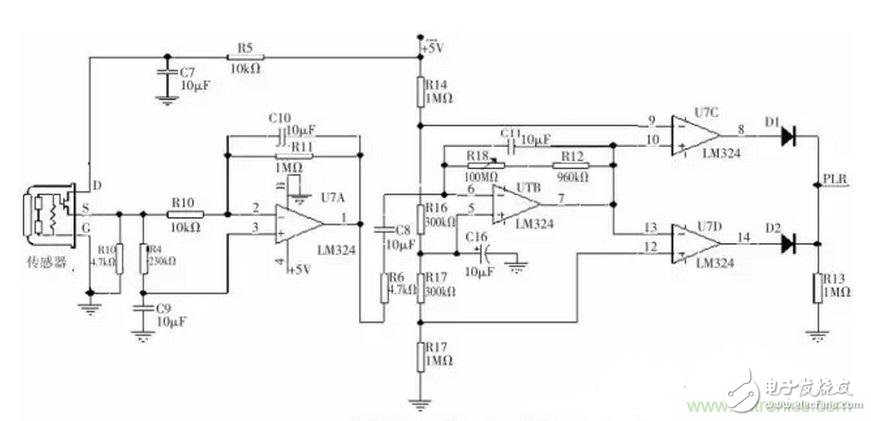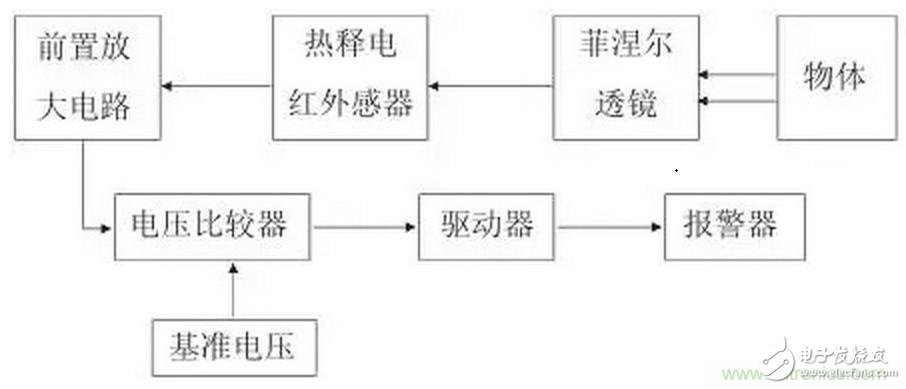With the popularization of information technology, infrared detection technology has developed rapidly and is widely used in night vision, alarm, medical and automatic control fields. In the infrared detection system, the infrared sensor is the core device, its performance determines the sensitivity of the entire infrared detection system, and the preamplifier circuit is a key part affecting the performance of the infrared sensor. Since the response signal of the infrared sensor is very weak, strict requirements are imposed on the preamplifier, such as low noise, high gain, good low frequency characteristics, and strong anti-interference.
The following is a new high-gain, low-noise preamplifier circuit design scheme for the characteristics of the output signal of the pyroelectric sensor. This scheme satisfies the requirements of the pyroelectric sensor for low noise, high gain, low frequency characteristics and strong anti-interference ability of the preamplifier.
First, the output signal characteristics and noise analysisThe amplitude and frequency of the pyroelectric infrared sensor output electrical signal are mainly determined by the temperature of the target human body, the background of the detection area, the distance between the human body and the sensor, the speed of the human body moving, the focal length of the optical lens system, and its design. The temperature difference between the human body temperature and the background of the detection area is large, and the closer the sensor is, the larger the amplitude of the output electrical signal will be. When the dual-sensitive pyroelectric sensor is used with a Fresnel optical lens, the peak-to-peak value of the output signal waveform is about 1 mV, and the frequency can be calculated by the following formula:

Where f is the output signal frequency (Hz); Vb is the human body moving speed (m/s); fb is the optical system focal length (mm); S is the area of ​​the sensor sensitive element (mm); L is the distance of the human body from the sensor (m). For dual sensitive sensor, the standard size is 2 & TImes; 1mm2, the human body moving speed range is 0.5 ~ 5m / s, the Fresnel lens used on common detectors has a focal length of 25mm, so we can calculate the frequency range of the sensor output signal It is 0.08 to 8 Hz.
Since the signal output from the sensor is very weak, it is susceptible to noise interference, and even the effective signal is submerged in the noise. The research found that the interference source of the output signal on the sensor mainly comes from the thermal noise of the sensor, the inherent noise, the voltage of the amplifier and the current noise. Thermal noise is generated by random thermal motion of charge carriers in the detector material. To reduce the impact of thermal noise, the distance between the pyroelectric infrared sensor and the preamplifier circuit should be shortened as much as possible to reduce external thermal interference, and a low-pass filter circuit is connected in the preamplifier circuit to limit the noise bandwidth. . The sensor's inherent noise voltage peak-to-peak is about 50μV, and the outdoor hot air flow can generate noise of nearly 250μV, which is also close to 180μV indoors. Other possible interferences, such as spatial electromagnetic interference and mechanical vibration, have noise amplitudes close to 100μV. The maximum amplitude of the three noise superpositions is close to 300μV.
Second, the design of the preamplifier circuitAccording to the output signal characteristics of the pyroelectric infrared sensor, the preamplifier circuit signal processing needs to extract useful weak signals from various noise interferences, so the preamplifier circuit should have low noise, high gain, good low frequency characteristics, and strong anti-interference ability. Features. Therefore, it usually consists of three parts including band pass filtering, two-stage high gain amplification, and comparison circuit as shown.

Figure 1 Infrared detection preamplifier circuit design
In the above figure, a 10kΩ resistor is connected in series between the D-side of the pyroelectric sensor and the 5V power supply to reduce RF interference. The G terminal is grounded, and the S terminal is connected to a 47kΩ load resistor. The bias voltage is about 1V. The sensor output is directly coupled to the bandpass filtering of the low noise op amp (LM324) and the inverting input of the first stage amplifying circuit, and then coupled to the second stage inverting circuit by the resistor R6 and the capacitor C8 for further filtering and amplification. .
The upper cutoff frequency is:

The lower cutoff frequency is:

The circuit gain is frequency dependent. When the input signal frequency is 1 Hz, the first stage amplification gain is approximately:

The second stage amplification gain is:

The calculated bandwidth is 15.83 Hz and the total circuit gain is 66 dB. The dual-limit voltage comparator consists of two other amplifiers from the four op amps (LM324). From the previous analysis of noise, the maximum amplitude of the noise source is close to 300μV. After the two-stage amplifier circuit, the maximum noise amplitude reaches 600mV. The second stage amplifying circuit is biased at VCC/2, which is 2.5V. Therefore, the high and low thresholds of the dual-limit voltage comparator should be set to 3.1V and 1.9V to effectively resist noise interference, that is, when the amplifier output signal level is greater than 3.1. When V is less than 1.9V, the comparator outputs a high level, indicating that the moving human body is detected.
Third, the application of pyroelectric infrared sensorPyroelectric infrared sensors are widely used and can be divided into qualitative measurement and quantitative measurement.
Quantitative measurement is the measurement of the temperature T of the infrared source, which is a non-contact method of measuring temperature. Its basic basis is as follows: First, the radiant energy flux density ωλ can be expressed as:

Where ωλ is the emissivity, which is equivalent to the correction of the absolute black body, which is a number less than or equal to 1; h is the Planck constant; λ is the wavelength, c is the speed of light; k is the Boltzmann constant; T is absolute temperature.
It can be seen from the formula that if the radiance of the light source is constant, the relative position of the infrared sensor and the light source and the optical system are fixed, the temperature of the sensor has a certain relationship with respect to the temperature of the light source.
The calender is actually used to calender the light source, so the temperature of the pyroelectric device reflects the temperature of the light source and sometimes reflects the temperature of the calender. Therefore, the amplitude of the ripple voltage outputted by the pyroelectric device is the temperature of the light source T, and the temperature of the calender is The difference between the two functions of the variable.
Qualitative measurement is the largest application area of ​​pyroelectric infrared sensors. Its basic principle is based on the difference between the nature of the detector and the background radiation, and the presence or absence of the detection target. The surface temperature of the human body is about 34 ° C, the peak value of infrared rays is about 10 μm, and the signal generated by human body movement corresponds to the frequency of 0.1 to 10 Hz. The method of pyroelectric detection has several characteristics compared with the visible light sensor. The first is to use the human body. The self-illumination does not require other light sources, so the working device is simple and reliable, and because the infrared rays are not perceived by people, it has the advantage of good concealability.
In recent years, pyroelectric infrared sensors are used in military and industrial applications such as remote sensing, guidance, night vision, active radar, thermal imaging, gas analysis, radiometers, and temperature measurement. Rapid growth. Currently the most widely used is the detection of human sensors, such as for anti-theft alarm systems.

Infrared alarm block diagram
The infrared rays emitted by the object first pass through the Fresnel lens and then reach the pyroelectric infrared detector. At this time, the pyroelectric infrared detector will output a pulse signal, and after the pulse signal is amplified and filtered, the voltage comparator compares it with the reference value, and when the output signal reaches a certain value, the alarm circuit issues an alarm. The preamplifier circuit adopts the first scheme designed in Fig. 1. The test shows that the low frequency characteristic of the signal processing circuit is better, and the low frequency weak signal outputted by the sensor has higher amplification gain and strong anti-noise interference capability. The experimental results of the circuit design also prove that the preamplifier signal processing circuit is used with the pyroelectric infrared sensor with high sensitivity and low detection error rate.
Fourth, summaryBy analyzing the output signal characteristics of the pyroelectric infrared sensor, the noise signal of the preamplifier circuit is analyzed and analyzed. It shows that the weak signal processing circuit has higher gain at low frequency, and the frequency characteristic curve is relatively flat near 1 Hz. The distortion is small when amplifying, and the 3dB bandwidth is only 15.94Hz, which can effectively filter out high-frequency interference, improve the signal-to-noise ratio, and meet the requirements of the pyroelectric infrared sensor output for signal processing circuit design. However, in the specific application, the impact of the actual detection environment on the sensor output signal should be fully considered, and the signal processing circuit should be properly selected and designed to reduce the error and maximize the detection of the infrared sensor.
Electro Gold Pcb,Electronic Circuit Board,Gold-Plated Circuit Board,Gold-Plated Process Circuit Board
Shenzheng Weifu Circuit Technology Co.Ld , https://www.wfcircuit.com